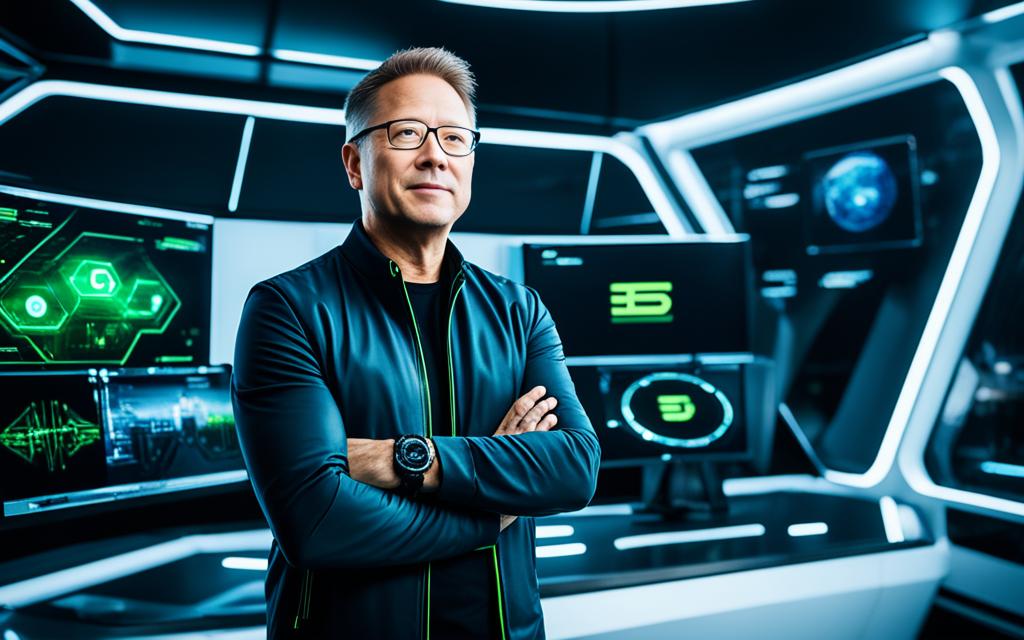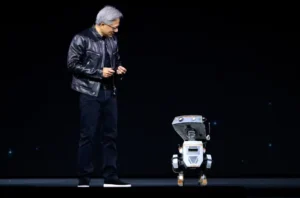Tech
Jensen Huang and NVIDIA’s Vision for the Future: Robots, Humanoids, and Self-Driving Cars in 2024
Published
5 months agoon
By
Admin
Jensen Huang, the charismatic and visionary co-founder and CEO of NVIDIA, has long been a driving force in the world of technology. As NVIDIA continues to push the boundaries of artificial intelligence (AI), machine learning, and computational graphics, its influence now extends beyond traditional gaming and data centers. The future of robotics, humanoid machines, and self-driving cars looks brighter than ever, largely due to NVIDIA’s breakthroughs in AI, and the leadership of Huang. In 2024, NVIDIA’s innovation is spearheading a new technological frontier that promises to reshape industries.
NVIDIA’s Role in AI and Robotics
NVIDIA is no stranger to AI, a field in which it has been a key player for years. The company’s graphics processing units (GPUs) have become essential in AI model training and deep learning, helping to accelerate computing power for various applications. But it’s not just about chips and data centers anymore. Huang’s vision extends to practical implementations of AI, such as robotics and autonomous systems.
Robotics, a critical component of the future of AI, has rapidly progressed over the last few years. With applications ranging from industrial automation to healthcare, robots are increasingly intelligent and capable. NVIDIA, through its Isaac robotics platform, is aiming to lead this revolution. The Isaac platform provides developers with the tools to build and deploy AI-powered robots that can learn from their environments and perform complex tasks. By leveraging powerful GPUs and AI algorithms, NVIDIA’s platform is enabling robots to navigate, interact, and make decisions autonomously.
Huang believes that robots are no longer limited to factories but will play a significant role in everyday human life. From logistics robots that assist in warehouses to healthcare robots providing care to elderly patients, NVIDIA is laying the groundwork for a future where intelligent robots become ubiquitous.
The Rise of Humanoid Robots

A particularly exciting area of development is humanoid robots—machines that not only perform tasks but also physically resemble humans. Huang has often spoken about how humanoid robots represent the next frontier of human-AI interaction. These robots are not just functional but are designed to engage with people in social settings, provide companionship, or assist with tasks requiring human-like dexterity.
NVIDIA’s Omniverse Avatar, a platform focused on creating realistic virtual representations of humans, is a precursor to actual humanoid robots. The goal is to create machines that can learn from human behavior, understand emotional cues, and interact in a natural way. Huang envisions humanoid robots being integrated into homes, assisting with daily chores, and serving as companions to those who need help. With advances in sensors, AI, and robotics, humanoid robots are expected to become more common, efficient, and affordable.
NVIDIA’s hardware, especially its GPUs and AI chips, is crucial to building these humanoids. By accelerating the training of AI models that can simulate human movements, understand complex speech, and recognize objects in real time, NVIDIA’s technology is enabling the development of robots that can replicate human-like behaviors. These advancements are ushering in a new era of humanoid robots that have the potential to revolutionize personal and professional life.
Self-Driving Cars: Accelerating Autonomous Mobility
NVIDIA’s impact on self-driving cars is another key area where Jensen Huang’s vision shines. The automotive industry has been chasing the dream of fully autonomous vehicles for years, and NVIDIA is a leader in providing the hardware and software platforms necessary to make this a reality. The company’s NVIDIA DRIVE platform is designed specifically for autonomous vehicles, providing the computational power needed to process data from cameras, sensors, and radar systems in real-time.
In 2024, self-driving cars are closer than ever to becoming a widespread reality, with NVIDIA playing a central role in this evolution. Huang’s approach emphasizes safety, scaleability, and reliability. The company’s DRIVE AGX Pegasus platform, capable of delivering over 320 trillion operations per second, is designed to support Level 5 autonomy—where vehicles operate without human intervention.
NVIDIA’s involvement extends beyond hardware. Through partnerships with major automakers and startups alike, the company provides software solutions that enable vehicles to map their surroundings, recognize traffic signals, and avoid obstacles—all in real-time. Deep learning, which is made possible by NVIDIA’s GPUs, plays a key role in enabling autonomous cars to learn from enormous volumes of data and enhance their decision-making abilities.
In addition to personal vehicles, Huang envisions autonomous fleets being deployed for commercial purposes. Ride-hailing services, long-haul trucking, and even public transport are sectors where self-driving vehicles powered by NVIDIA’s technology could drastically reduce costs, improve efficiency, and enhance safety.
AI and Ethics: Huang’s Commitment to Responsible Innovation
As Jensen Huang pushes forward in AI-driven innovations, ethical considerations are always a central theme. The use of robots, humanoids, and autonomous vehicles raises questions about privacy, safety, and the potential displacement of jobs. Huang has been vocal about the need to establish guidelines that ensure AI benefits society without causing harm.
For example, in the case of self-driving cars, Huang stresses that safety must always come first. NVIDIA has invested in safety protocols, real-time monitoring, and advanced simulations to ensure that autonomous vehicles behave reliably in unpredictable environments. Similarly, with humanoid robots, ethical AI guidelines need to be in place to ensure that these machines interact with humans in a way that respects privacy and autonomy.
NVIDIA has also advocated for transparent AI, where systems can explain their decisions to humans. This is particularly important for robotics and self-driving cars, as users need to trust these technologies in critical, potentially life-saving situations. Huang is committed to working with governments and organizations to ensure that AI developments align with the broader goals of society.
The Future of AI with Jensen Huang at the Helm
Jensen Huang’s leadership has cemented NVIDIA’s position as a pioneer in AI, with its influence extending far beyond the company’s origins in gaming hardware. The intersection of robotics, AI, and autonomous vehicles represents a pivotal moment in human history, one that Huang is helping to shape with foresight and precision. By 2024, the impact of his work will be seen across multiple industries, from logistics and healthcare to transportation and personal robotics.
The world Huang envisions is one where robots work side-by-side with humans, autonomous vehicles transform mobility, and AI seamlessly integrates into daily life. NVIDIA, under Huang’s guidance, is not only building the technological infrastructure necessary to realize this future but also doing so with an emphasis on ethical responsibility and societal benefit.
As we move further into the AI age, Jensen Huang and NVIDIA are leading the charge into a world of intelligent robots, humanoid companions, and self-driving cars. The advancements in these areas are poised to make 2024 a pivotal year in the history of technology, forever changing the way we live, work, and interact with machines.
You may like

Efficient ACA Compliance Management with ACA-Track

Key Software Systems: Future-Proofing Courier Operations with Technology

Refrigerated Trailers: Benefits and Uses

100 Dynamic Duos: Legendary Pairings That Transcend Time
ARK: Survival Evolved Game Icons and Banners

cute:i1cdycptg50= drawings

Understanding New York Sports Club Membership: What It Offers and What Affects the Cost

Safety Tips for Compressed Air Dryers

drawing:23vyczbybxu= billie eilish

drawing:056aoyw74ce= rick and morty

How can online food delivery sales increase and attract the maximum number of customers in 2023?

MEP BIM: Revolutionizing Building Infrastructure Design

Revolutionizing Industries with ChatGPT

Resolving the Israeli-Palestinian Conflict: A Comprehensive Analysis

Skillful Passion: Wisconsin’s Dominant Volleyball Team

Virtual Reality Rental: A Futuristic Experience

Unlocking the Potential of cryptonewzhub.com Internet

Negin Behazin vs Dignity Health: Comprehensive Comparison

Unraveling the Mystery: Robert Card’s Tragic Passing

iPhone 14 Pro Max: Unveiling the Next Level Innovation

Efficient ACA Compliance Management with ACA-Track

Key Software Systems: Future-Proofing Courier Operations with Technology

Refrigerated Trailers: Benefits and Uses

100 Dynamic Duos: Legendary Pairings That Transcend Time
ARK: Survival Evolved Game Icons and Banners

cute:i1cdycptg50= drawings

Understanding New York Sports Club Membership: What It Offers and What Affects the Cost

Safety Tips for Compressed Air Dryers

drawing:23vyczbybxu= billie eilish

